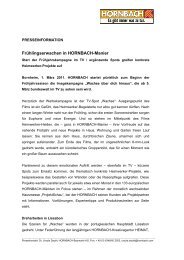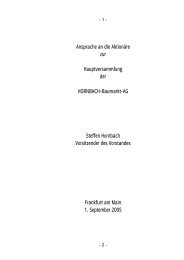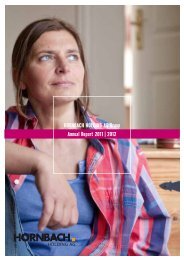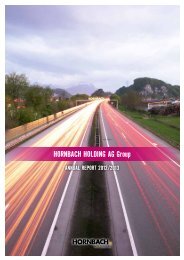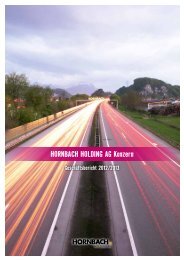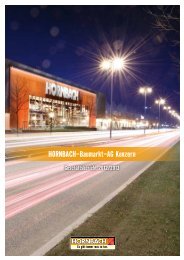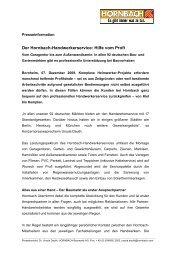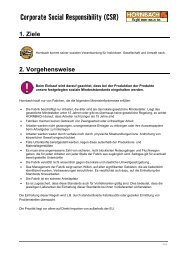Hornbach-Baumarkt-AG Group
PDF, 3,6 MB - Hornbach Holding AG
PDF, 3,6 MB - Hornbach Holding AG
- No tags were found...
You also want an ePaper? Increase the reach of your titles
YUMPU automatically turns print PDFs into web optimized ePapers that Google loves.
96 NOTES TO THE CONSOLIDATED FINANCIAL STATEMENTS Explanatory notes on the principles and methods applied in the consolidated financial statements<br />
quired to date under IAS 27, IAS 28 und IAS 31. The new standard requires first-time application in financial<br />
years beginning on or after January 1, 2014. First-time application of the amended standard is not<br />
expected to lead to extended note disclosures in the consolidated financial statements of HORNBACH-<br />
<strong>Baumarkt</strong>-<strong>AG</strong>.<br />
• IFRS 13 "Fair Value Measurement": This standard lays down uniform requirements for fair value measurement<br />
in IFRS financial statements. In future, all fair value measurements called for by other standards<br />
will have to comply with the uniform requirements of IFRS 13. Only IAS 17 and IFRS 2 will continue to be<br />
governed by their own requirements. IFRS 13 defines fair value as the exit price, i.e. as the price that<br />
would be obtained upon the sale of the asset, or the price that would have to be paid to assign a liability.<br />
A three-level hierarchy system graded in terms of dependence on observable market prices is to be introduced<br />
in line with the system already known for the fair value measurement of financial assets. This new<br />
method of fair value measurement may result in values that differ from those determined in line with existing<br />
requirements. The new standard requires first-time application in financial years beginning on or<br />
after January 1, 2013. First-time application of the amended standard is not expected to have any material<br />
implications for the future consolidated financial statements of HORNBACH-<strong>Baumarkt</strong>-<strong>AG</strong>.<br />
Standards, interpretations and amendments published as of the balance sheet date, but not yet adopted<br />
into European law by the EU Commission<br />
The following requirements had been published in English by the IASB and the IFRIC but not yet endorsed by<br />
the EU as of the balance sheet date.<br />
• IFRS 9 "Financial Instruments": The recognition and measurement of financial instruments in line with<br />
IFRS 9 is set to replace IAS 39. In future, financial assets will be classified and measured in only two<br />
groups - at amortized cost and at fair value. The group of financial assets measured at amortized cost<br />
consists of those financial assets which only provide for a right to payment of interest and principal<br />
amounts at specified dates and which are also held within a business model whose objective is the holding<br />
of assets. All other financial assets belong to the group measured at fair value. As previously, financial<br />
assets in the first category may be redesignated to the fair value category in specific circumstances<br />
("fair value option"). Changes in the value of financial assets in the fair value category must basically be<br />
recognized through profit or loss. For specific equity instruments, however, use may be made of the option<br />
of recognizing changes in value under other comprehensive income; dividend claims relating to these assets<br />
must nevertheless be recognized through profit or loss. The requirements for financial liabilities have<br />
basically been taken over from IAS 39. The main difference relates to the recognition of value changes for<br />
financial liabilities measured at fair value. In future, these will have to be broken down. The portion allocable<br />
to a company's proprietary credit risk must be recognized under other comprehensive income, while<br />
the remaining portion of the change in value must be recognized through profit or loss. Subject to adoption<br />
into EU law, which is still outstanding, IFRS 9 will require first-time application in financial years beginning<br />
on or after January 1, 2015.<br />
• Amendments to IFRS 9 and IFRS 7 “Mandatory Effective Date and Transition Disclosures”: These amendments<br />
enable users to forego stating adjusted previous year’s figures upon the first-time application of<br />
IFRS 9. Originally, this relief was only possible if premature application was made of IFRS 9 prior to January<br />
1, 2012. This relief involves additional note disclosures for IFRS 7 upon the date of transition. Subject<br />
to adoption into EU law, which is still outstanding, these amendments – by analogy with the requirements<br />
of IFRS 9 – will require first-time application in financial years beginning on or after January 1, 2015.



